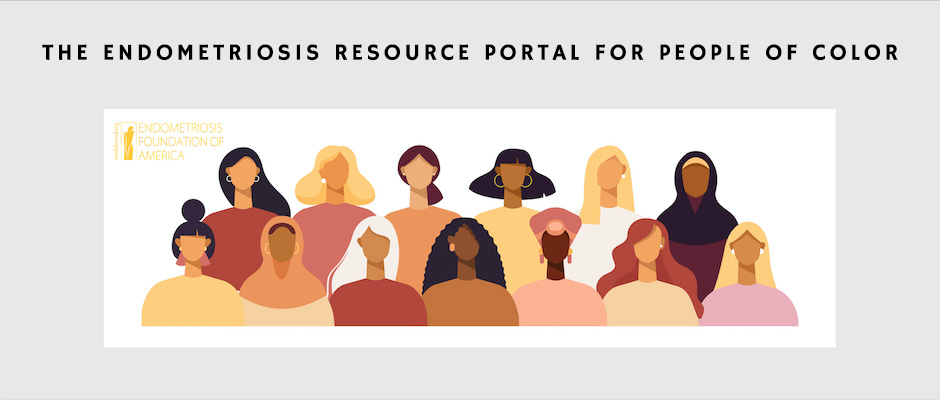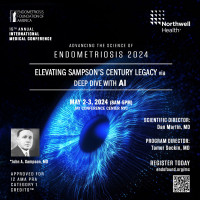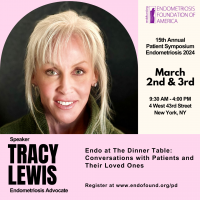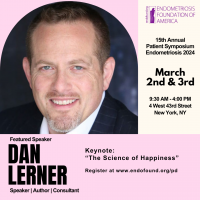
Endometriosis treatment and support is vastly under-funded and continues to be an incredibly difficult disease to diagnose and treat. Black, Indigenous, and POC individuals face these barriers to receiving proper diagnosis and treatment in higher numbers.
Many Black or Brown individuals google endometriosis for the first time, see the misinformation that endometriosis is only a white women’s disease, and look for another cause for their pain. It is then common for that person to lose years of their lives due to misdiagnosis and improperly-managed and incorrectly-treated pain. As minimally invasive gynecology surgeon and endo patient Dr. Soyini Hawkins shares in her video, she was taught that an endo patient typically looks like a young, slim, caucasian woman. This is incorrect, as endometriosis can affect people of every race and ethnicity. The purpose of this resource portal is for people of color who are experiencing pain and suspect they may have endometriosis to receive the correct information and hear from patients who look like them and have had similar experiences with the disease.
This portal is an ongoing project. In addition to videos from patients and doctors with endometriosis, we’ve included resource pages of symptoms to watch out for and questions to ask a doctor. You can also find research articles that highlight the racial and ethnic disparities in endometriosis care, as well as organizations that are working towards racial justice in public and women’s health. We'd love to hear about other resources that folks have found helpful. We’re also hoping to highlight more stories of BIPOC individuals with endometriosis. Please email info@endofound.org if you’d like to tell your story or have any questions.
The History of Endometriosis and Racial Inequity
Despite a growing awareness of racial and ethnic disparities in healthcare, inequitable care among different racial, ethnic, and socioeconomic groups continue to this day. This is particularly true for endometriosis, a disease that was traditionally believed to have a higher prevalence among white, middle-class women.
Dr. Joseph Vincent Meigs was a significant contributor to this belief in the 1930s. He described observing a higher incidence of endometriosis in his private patients than those in the hospital ward. As noted by Bougie et al. in their research article Behind the times: revisiting endometriosis and race, these “labels of private or ward patient carried both racial and socioeconomic connotations, conflating race and class in the medical literature.” These labels suggested that endometriosis was more common in white, middle-class women and was rare in non-white women. Meigs believed that white, well-off women who delayed childbearing and thus had long periods of uninterrupted menstruation were susceptible to pathologic changes that caused endometriosis. Thus the myth of endometriosis as a white, working woman’s disease was born.
In the 1970s, African-American gynecologist Doland L. Chatman explained how this belief affected the wellbeing of patients. He noted that 40% of his patients with signs and symptoms of endometriosis were previously misdiagnosed with pelvic inflammatory disease and were not receiving the treatment they needed.
Unfortunately, the myth that endometriosis is a white woman’s disease persists today and results in a diagnostic bias that continues to affect patient care. To make matters worse, other beliefs about health and race/ethnicity make adequate endometriosis care difficult for certain groups. For example, in a study conducted by Hoffman et al., 50% of white medical students and residents were found to have false beliefs about biological differences between Blacks and whites and consequently were less accurate in their pain treatment recommendations for Black patients, resulting in insufficient pain relief.
These myths, combined with other social factors, create barriers to treatment. In the United States, there is a striking racial inequality in socioeconomic status: both Blacks and Hispanics have levels of overall poverty two to three times higher than whites. This affects access to care in myriad ways: lower levels of insurance coverage, less access to quality providers, and inadequate health education and health literacy.
Access to care also affects endometriosis research. Endometriosis studies that require patients to have a surgical diagnosis of endometriosis may exclude certain races and ethnicities, leading to inadequate representation of these groups in these studies. If patients cannot access surgery in the first place, how can they qualify for research that requires a surgical diagnosis for them to be included in studies? Furthermore, in addition to access, some individuals may not prefer surgery due to cultural reasons. This choice highlights another problem in endometriosis research: it does not account for how social and cultural factors play a role in endometriosis. For example, research has suggested that endometriosis symptoms may present differently based on race and ethnicity, though little has been done to investigate this.
It is time that everyone, from healthcare providers to the general public, recognizes that endometriosis can occur in individuals of any race. Future research must take an inclusive approach and consider the socioeconomic realities in the US that make endometriosis care more difficult for Black people and people of color to access.
References:
https://www.ajog.org/article/S0002-9378(19)30322-9/abstract
https://www.uptodate.com/contents/racial-and-ethnic-disparities-in-obstetric-and-gynecologic-care-and-role-of-implicit-biases
https://www.fertstert.org/article/S0015-0282(10)00980-5/fulltext
https://pubmed.ncbi.nlm.nih.gov/20201869/
https://obgyn.onlinelibrary.wiley.com/doi/full/10.1111/1471-0528.15805
Patient Stories - Videos
These endometriosis patients share their diagnostic journeys, as well as tips for managing endometriosis symptoms, pursuing proper treatment, and advocating for yourself as a person of color with endometriosis. We encourage you to use these videos in conjunction with the Resource Sheet for Endometriosis Patients of Color to arm yourself with as much information and support as you need to receive proper diagnosis, management tools, and treatment.
Kyla Canzater
Kyla Canzater first experienced endometriosis pain around the age of 12 with her first cycle. She googled her symptoms and found that endometriosis matched everything she was going through. However, when Kyla took this information to doctors and told them her symptoms, it was as if she was speaking another language.
It took her 5 doctors and 13 years before she was actually diagnosed with endometriosis. She was 29, working her first full-time job, and happy to have health insurance. And it was only then that she was able to find minimally invasive gynecology surgeon Dr. Hawkins in Baltimore. “She actually listened,” Kyla says. “She took my pain seriously and decided it was time for me to have a laparoscopy.”
Kyla emphasizes the critical role her support system played in her diagnosis journey. She only saw Dr. Hawkins because her mother suggested seeing a specialist. “[My mother] was there every step of the journey trying to figure it out,” Kyla says. “Everytime a doctor asked if it was all in my head or if I was sexually active, my mother was there to help me navigate my thoughts and understand that it wasn’t my fault that I was going through this.”
Kyla’s tips for people of color going to doctors for pain? Do not take a bandaid as a solution. “If your doctor isn’t giving you the solution you need,” she says, “it’s time to find another doctor. And don’t be afraid to find a specialist. I’m not the only woman who had to jump out the window and find a specialist to find the answers to their problem.” And, she adds, the pain is not just in your head. In order to get the answers you need from doctors, Kyla also recommends keeping a pain journal. “Don’t just say you’re dealing with pain,” she advises. “Let them know what type of pain. Let them know where your pain is and how often you’re experiencing it. Let them know that you're having pain beyond your cycle. Let them know when you’re moody. Let them know when you cry. Let them know when your back aches. Let them know everything. Because endo is something that affects your entire body.”
Samantha Denäe
Sam, who experienced debilitating, 8-day long periods, was unable to go to school, work, walk, or perform normal activities before she was diagnosed in 2014. She had no idea she was having endometriosis symptoms. Every doctor she saw said the same thing: your bad period will get easier with time, and if you have kids. But as Sam got older, her period was getting worse. When she almost overdosed on codeine, she describes the experience as a blessing in disguise. “That was when I first heard the word endometriosis,” Sam says, “and I had a physician listen to my symptoms and listen to everything I was going through and say, ‘I believe you have endometriosis.’” In the medical community there is a still-prevalent misconception that Black people are able to withstand and tolerate pain at a higher threshold than other people.
And when Sam was first diagnosed, she could only find caucasion women who had endometriosis. She would ask doctors about Black women and how they are specifically affected with endo, and they would tell her, it’s a white woman’s disease. “They believed that in Black women [endo] is invisible,” Sam says, “it doesn’t exist. To them we mostly get fibroids and nothing else.” For five years, Sam experienced 90 day periods, and had scheduled three hysterectomies before cancelling them. “That’s usually what they like to offer black women and women of color,” she explains, “I cancelled each one with an intuitive feeling that that’s not the path I should be taking to heal my endo. “
Cultural norms present a major barrier towards diagnosis, and it was difficult for Sam to tell her family about the disease. “In the black community we don’t go to the doctor when we should,” Sam adds. “But the more we talk about endo especially in the Black community, the more we can get earlier diagnosis, the more we can decrease the chance of cancer when it comes to reproductive health.” Our pain, Sam says, can be transformed.
Kanwal Ojha
Kanwal Ojha first began experiencing symptoms relating to endo when she got her period at the age of eleven. She had cramps, vomiting, diarrhea, and heavy periods. She was diagnosed three years later, and attributes the delay to a few critical factors: her young age, race, culture, and gender. People tend to not take children’s pain as seriously, Kanwal explains. There is also a historic pattern for people to perceive the pain of women as less than men—particularly white men—and this occurs most frequently for Brown and Black women. Kanwal adds that cultural norms also play a major role in diagnostic delay, as in her Pakistani culture, people don’t discuss women’s health. She first told only her mother, then her father, but her parents warned her against speaking to family friends about her pain. She couldn’t even tell her brother, her best friend, for many years. “For me as a child that was very hard,” Kanwal explains, “because I felt stigmatized. I thought, wow, I have something that is considered unspeakable, that I can’t talk to other people about because they will think less of me and my family. I just knew that wasn’t fair.”
A few years later, as Kanwal started learning more about endometriosis, she found that none of the women speaking openly about the disease looked like her. Kanwal recognized that yes, they have the same physical pain as her, but what about the emotional experience that comes with this pain? One rooted in varied cultural norms, different stigmas, and identity? Now, Kanwal says, she is encouraged by the fact that many more women who look like her or have had similar experiences to her are opening up about their experience.
Lauren Kornegay
Before Lauren was diagnosed, she never thought to google her symptoms. Lauren explains that Black women and women of color are taught not to discuss their menstrual cycle. As a result, she thought the pain she experienced, as well as her irregular cycles, was normal. Lauren’s diagnosis was easier, she says, than most people’s: 7 years. For many Black women, Lauren says, it takes much longer, and unfortunately this stems from systematic racism rooted in the misconception that Black women can tolerate pain at a higher level than other races, as well as socioeconomic factors such as zoning. “You may not have access to a really good hospital,” Lauren says, “or a really good doctor to find out if something is wrong.”
Lauren also shares critical and highly informative tips for Black endo patients and patients of color. “When you’re going to the doctor for pain,” Lauren says, “I would advise you to be open-minded. Set your expectation for the fact that not everyone may meet your standard.” She also recommends documenting all the pain that you’ve been going through. And if you don’t get the responses you’re looking for, the next step is to get a second opinion, and a third, and a fourth. Keep your mental health in mind as well. It can be incredibly taxing to be told repeatedly by medical professionals that your pain doesn’t exist. Doctors may not take your pain seriously, and you’ll want to brace yourself for this possibility.
Lauren also stresses the importance of paying attention to diet, pointing to soul food in particular. “Unfortunately,” Lauren says, “soul food is not always good for your health, and can be the cause for so many health concerns such as high cholesterol, diabetes, obesity.” Pay attention to the food that you’re putting in your body and whether they cause an endo flare up. “I’m not suggesting keto or vegan,” Lauren adds. “There’s no particular diet for endo patients. Do your research and do a trial and error of what you’re good with.”
Patient Stories - Personal Essays
Do Not Wait for the Knife to Hit Your Bone: Bassima Mroue's Endo Story
From School to the Emergency Room: Itzel Sanchez's Endo Story
Remaining to be Seen: Aditee Kissoon’s Endo Story
I Was Angry for My Younger Self: Medical Student Kanwal Ojha’s Endo Story
Chronicles of Pain: Yadira Ramos' Endo Story
It took me twenty years to get answers: Merve Aypak's Story
The Hospital Became My Second Home: Patricia Hackshaw's Endo Story
Endo as a GYN: Dr. Aneela Ambareen's Endo Story
My Year of Tenacity, Patience, and Perseverance: Monae' Smith's Endo Story
The Day I Got The Answers I Needed: Jatava Burns' Endo Story
Enduring the Pain: Althercia Stephenson's Endo Story
My 900 Days Lost to Endo: Amrita Rajagopal’s Endo Story
How A Diagnosis of Uterine Fibroids Delayed Endo Treatment: Ruby Tolbert's Endo Story
Endometriosis Specialists & Doctors
What should endometriosis patients of color know? What does endometriosis look like outside of the standard textbook defintion? How can doctors address diagnositc racism moving forward? Dr. Soyini Hawkins, M.D., M.P.H., and minimally invasive gynecology surgeon at the Fibroid and Pelvic Wellness Center of Georgia, speaks on these critical points.
Dr. Soyini Hawkins
Dr. Soyini Hawkins is a minimally invasive gynecology surgeon as well as an endo warrior. Dr. Hawkins endometriosis diagnosis was happenstance; she was diagnosed through fibroid surgery. “I was missing the diagnosis because I was diagnosed late,” Dr. Hawkins says, “however I never even gave anyone the opportunity to find endo.” She explains that most women go through three to five doctors before anyone listens. And, patients may not describe their pain as bluntly and clearly: that this pain is inhibiting their life and impacting their daily living. “I encourage especially Black women to feel empowered enough to advocate for themselves when they do go to the doctor,” Dr Hawkins says. “Empowered enough to take notes and write down their symptoms so that when they go they can paint their picture and insist that somebody listen.”
In this video, Dr. Hawkins addresses the best treatment for endometriosis, what every endometriosis patient of color should know, what endo looks like outside the standard textbook definition, as well as the steps that doctors can take to dismantle diagnostic racism and inequality in women’s health. What should every endometriosis patient of color know? That endometriosis sees no color. Endometriosis sees no culture, or ethnicity, and is not specific to just one type of woman or to one type of sexuality. “Endo doesn’t discriminate. So when we look at textbooks or sometimes when we talk to physicians about our pelvic pain and discomfort, endo doesn’t come into their mind as auto because we don’t look like a textbook definition of what endometriosis is. Endo women of color should know that we can be sufferers of the disease too.”
When Dr. Hawkins was trained, she was taught that an endo patient very typically looks like a young, slim, caucasian woman. “She might look like an athlete,” Dr. Hawkins explains, “very healthy looking, and has pain with every cycle since she started her cycle.” But endometriosis has no weight restriction, no height restriction, no race restriction. And, Dr. Hawkins adds, endometriosis also doesn’t always carry a history of pain in each patient.
Dr. Hawkins also shares critical steps that doctors can take to dismantle diagnostic racism and inequality in women’s health. Dr. Hawkins is a strong believer in being truly diagnostic; her goal is to ensure that every patient gets the same type of care, attention, and problem solving. “Racial inequality says that we are making preconceived conclusions about our patients and what their symptoms may actually equate to even before evaluation,” she explains. “Every patient who comes in with pain should receive a pain and a diagnostic ultrasound: to make sure we’re ruling out other things as well as ruling in what might be there.”
Additional Resources & Education
Resource Sheet for Endometriosis Patients of Color
This patient resource sheet is geared specifically towards endometriosis patients of color and covers endometriosis 101, including symtpoms, management options, and proper treatment. We encourage you to use this resource sheet as well as this portal to arm yourself with as much information and support as you need to receive proper diagnosis, management tools, and treatment.
Demand Change with the Black Women's Health Coalition
Samantha Denäe, Lauren Kornegay, Kyla Canzater, and April Christina launched the Black Women’s Health Coalition on June 26th, 2020. The BWHC mission is to change inequitable healthcare for individuals of color by advocating for six essential actions that hospitals should take. The six demands are urgent and necessary. Equity accountability, health education for adolescents, diversity training, prejudice free communication, pain management protocol, and inclusivity in research. Sign the Black Women’s Health Coalition’s petition demanding change in the medical community for Black women and people of color here. You can also use their handy template to create easy-to-send letters to the ten major hospitals.
Research on Racial & Ethnic Disparities in Endo Treatment and Women’s Health
EndoNews, a subscription newsletter of EndoFound, covers recent research from around the world on endometriosis. Because research articles are often protected by a paywall, EndoNews provides objective summaries of these articles in order to make this critical information more accessible. We hope to educate the community on racial and ethnic disparities in endometriosis diagnosis and treatment by sharing the research articles that highlight it. Below, you can find the EndoNews summaries of the research articles we’ve compiled.
- Behind the times: revisiting endometriosis and race (American Journal of Obstetrics & Gynecology)
- Racial bias in pain assessment and treatment recommendations, and false beliefs about biological differences between blacks and whites (PNAS)
- ACOG Committee Opinion No. 649: Racial and Ethnic Disparities in Obstetrics and Gynecology (Obstetrics & Gynecology)
- Race, Socioeconomic Status, and Health: Complexities, Ongoing Challenges, and Research Opportunities (Annals of the New York Academy of Sciences)
- East and South East Asian Ethnicity and Moderate-to-Severe Endometriosis (The Journal of Minimally Invasive Gynecology)
- Racial/Ethnic Disparities/Differences in Hysterectomy Route in Women Likely Eligible for Minimally Invasive Surgery (The Journal of Minimally Invasive Gynecology)
- Health inequities take a societal toll (Obstetrics and Gynecology News)
- Taking Race Out of Human Genetics (Science)
We’ve also included a few more research articles which EndoNews has not yet covered:
- How Race & Ethnicity Influences Endometriosis (Contemporary OBGYN)
- Disparity in endometriosis diagnoses between racial/ethnic groups (BJOG: An International Journal of Obstetrics and Gynaecology)
- Influence of Race/Ethnicity on Prevalence and Presentation of Endometriosis: A Systematic Review and Meta-Analysis (BJOG: An International Journal of Obstetrics and Gynaecology) Additional commentary (BJOG: An International Journal of Obstetrics and Gynaecology
- The Role of Ethnicity in the Treatment of Uterine Fibroids With Ulipristal Acetate (The Journal of Minimally Invasive Gynecology)
- Racial and Ethnic Disparities in Complication Rate in Patients Undergoing Myomectomy (The Journal of Minimally Invasive Gynecology)
Organizations
These organizations and resources enact racial and social justice in public health and women’s health.
- EndoBlack
- Groundswell Fund
- Third Wave Fund
- National Latina Institute for Reproductive Justice
- Black Women’s Health Imperative
- In Our Own Voice: National Black Women’s Reproductive Justice Agenda
- Sister Reach
- Sister Song
Thank you to Kyla Canzater, Lauren Kornegay, Samantha Denäe, Kanwal Ojha, and Soyini Hawkins for sharing their stories. A special shout out to Kyla Canzater, Latia Lee, and Karli Goldstein for helping produce this portal. If you’re a person of color with endometriosis and would like to share your story on this portal, please email info@endofound.org.







